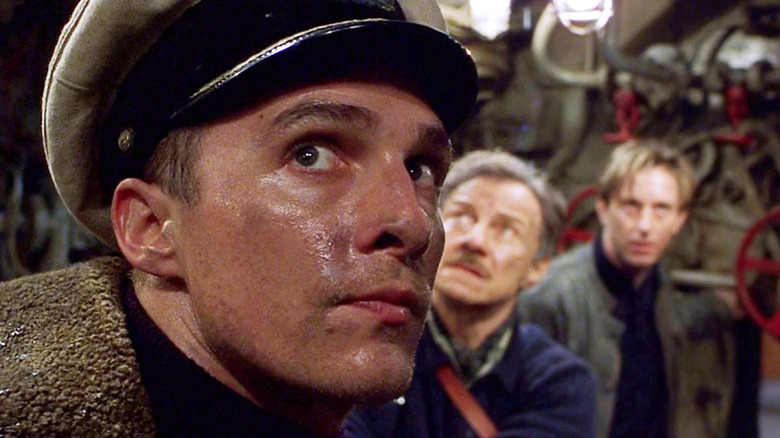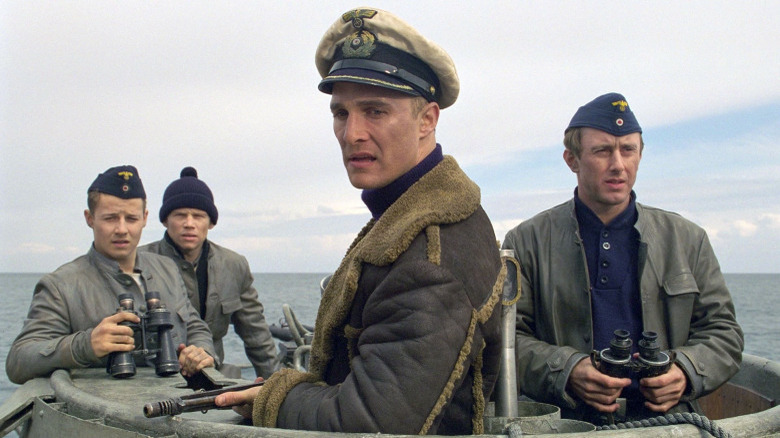Why U-571 Was Marred By Controversy In The UK
We Americans have a bad habit of taking credit for things we really shouldn't in historical movies that are, supposedly, based on facts. Remember "Argo," the Best Picture Oscar-winning 2012 film where the CIA all but single-handedly saves the day during the Iran Hostage Crisis? In truth, the Canadian ambassador to Iran at the time, Ken Taylor, and Canadian embassy employee John Sheardown (who's not even in the movie) were far more directly involved in the rescue operation than the on-screen version of the story indicates.
Compared to 2000's "U-571," however, "Argo" is a stickler for facts. Directed by Jonathan Mostow ("Breakdown," "Terminator 3: Rise of the Machines"), the WWII thriller follows a group of U.S. Navy officers on a mission to board a damaged German U-boat, U-571, while pretending to be a German supply vessel and steal the Enigma machine used by Nazi Germany for coding its communications that's onboard. At the heart of the story is Lt. Andrew Tyler (Matthew McConaughey), a wannabe submarine commander who gets a crash-course in just how hard that job really is when the operation goes sideways, and he's forced to lead the survivors to safety by assuming control of the captured U-571.
Visually, Mostow and "U-571" director of photography Oliver Wood (the first three "Bourne" films) achieve a rich sense of verisimilitude with their portrayal of the wet, cramped interiors of WWII-era U-boats, especially in the tense scenes where Andrew and his crew try to avoid being detected by diving deeper into the ocean as German destroyers bombard their vessel with depth charges. Of course, it wasn't the film's depiction of historical nautical warfare that garnered controversy so much as the way it suggests the U.S. was responsible for capturing the first Enigma machine in real-life.
The truth about U-571
The film's historical inaccuracies were broken down by The Guardian in 2009, starting with the fact that the first German Enigma machine was captured in February 1940 by the Royal Navy vessel HMS Gleaner, well before "U-571" takes place in the spring of 1942. What's more, the Enigma had already been broken by British cryptologists at Bletchley Park in June 1941, six months prior to the U.S. formally entering WWII after the Pearl Harbor bombing in December 1941.
"U-571" plays similarly fast and loose with the history of the titular U-boat, which was a real ship but was actually sunk in battle off the coast of Ireland in 1944. Indeed, the movie's plot seems to have been partly inspired by a similar operation in which the crew of a British vessel, the HMS Bulldog, boarded the German submarine U-110 after damaging it with depth charges and captured its Enigma machine along with its codebooks. This event was known as Operation Primrose and took place in May 1941. By that time, the scientists at Bletchley Park already had access to a number of Enigma machines but were aided directly in their efforts by the stolen codebooks.
As you might imagine, the UK government didn't take kindly to "U-571" rewriting the facts and giving the U.S. credit for something the British Royal Navy did. Brian Jenkins, a Labour MP at the time of its release in 2000, decried the film as an "affront to the memories of the British sailors who lost their lives on this action," with then-Prime Minister Tony Blair adding, "We hope that people realize these are people that, in many cases sacrificed their lives in order that this country remained free."
'It was a distortion'
For as much as "U-571" draws (very loosely) from the real-life history of WWII, it was also partly inspired by co-writer David Ayer's experiences serving on a U.S. Navy submarine prior to the start of his filmmaking career. Speaking to BBC Radio 4 in 2006, Ayer expressed his regret about the movie's revisionist history, calling it "a distortion... a mercenary decision to create this parallel history in order to drive the movie for an American audience." He added that his own grandparents had served in WWII, admitting that he would've been "personally offended if somebody distorted their achievements."
Ayer went on to share a story about his meeting with one of the real-life veterans involved in the early capture of an Enigma machine:
"I met with the Royal Navy officer who actually went down into the U-boat and recovered the Enigma machine in 1941. He seemed OK with [the way 'U-571' portrayed things], he was a great guy, but I understand how important that event is to the UK, and I won't do it again."
Interestingly, "U-571" actually nods to the fact that its story is a work of fiction based on real events. As the movie's final shot fades to black, a title card appears reading, "This film is dedicated to the bravery of Allied sailors and officers who risked their lives capturing Enigma materials from U-boats during the Battle of the Atlantic." It goes on to list the names and achievements of the HMS Bulldog, the HMS Aubretia (which aided the Bulldog in capturing U-110), the HMS Petard (which captured a "short weather cypher" from U-559 in October 1942), and the U.S. Navy Task Force 22.3 (which captured Enigma material from U-505 in June 1944).
As the saying goes, though, a picture is worth a thousand words — meaning, in the case of "U-571," the movie's first 110 minutes or so left a much stronger and more lasting impression on audiences than its brief attempt to set the record straight at the end.


